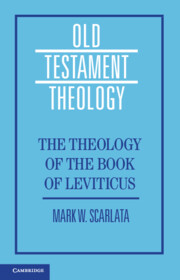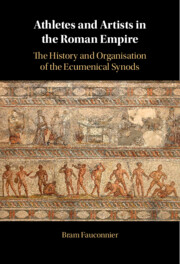Refine search
Actions for selected content:
41 results
Chapter 10 - Gods – What Are They Good For?
-
-
- Book:
- Reassessing the Peloponnesian War
- Published online:
- 21 August 2025
- Print publication:
- 04 September 2025, pp 272-327
-
- Chapter
- Export citation
Chapter 7 - Leviticus in the Old Testament and Beyond
-
- Book:
- The Theology of the Book of Leviticus
- Published online:
- 18 July 2025
- Print publication:
- 07 August 2025, pp 234-262
-
- Chapter
- Export citation

The Theology of the Book of Leviticus
-
- Published online:
- 18 July 2025
- Print publication:
- 07 August 2025
2 - Coming (Back) to Life
- from Part I - Imperial Phenomenology of Lyric
-
- Book:
- Aelius Aristides and the Poetics of Lyric in Imperial Greek Culture
- Published online:
- 01 May 2025
- Print publication:
- 15 May 2025, pp 64-100
-
- Chapter
- Export citation
6 - Visual Sources for the Study of Ottoman History
- from Part I - Sources and Structures
-
-
- Book:
- The Cambridge Companion to Ottoman History
- Published online:
- 31 May 2025
- Print publication:
- 20 March 2025, pp 84-100
-
- Chapter
- Export citation
Chapter 2 - Memory and Revolution
-
- Book:
- Liturgy, Ritual, and Secularization in Nineteenth-Century British Literature
- Published online:
- 14 November 2024
- Print publication:
- 21 November 2024, pp 46-70
-
- Chapter
- Export citation
21 - Festivals as a Forum for Indigenous Public Ceremony from Remote Australia
- from Part IV - Institutions
-
-
- Book:
- The Cambridge Companion to Music in Australia
- Published online:
- 14 November 2024
- Print publication:
- 14 November 2024, pp 327-345
-
- Chapter
- Export citation
8 - Ritual Law
- from Part III - The Biblical Laws
-
-
- Book:
- The Cambridge Companion to Law in the Hebrew Bible
- Published online:
- 11 April 2024
- Print publication:
- 18 April 2024, pp 158-178
-
- Chapter
- Export citation
Chapter 1 - Neither Jewish nor Pagan?
-
- Book:
- The Early Christians
- Published online:
- 05 October 2023
- Print publication:
- 26 October 2023, pp 25-115
-
- Chapter
- Export citation
Chapter 4 - Repertoire Politics
-
- Book:
- State of the Arts
- Published online:
- 03 August 2023
- Print publication:
- 17 August 2023, pp 122-160
-
- Chapter
- Export citation
36 - Socrates’ Cock and Daphnis’ Goats: The Rarity of Vows in the Religious Practice of the Greek Novels (2012)
-
- Book:
- Essays on Ancient Greek Literature and Culture
- Published online:
- 10 October 2023
- Print publication:
- 27 July 2023, pp 696-742
-
- Chapter
- Export citation
Chapter 7 - Plutarch at the Symposium
-
-
- Book:
- The Cambridge Companion to Plutarch
- Published online:
- 29 June 2023
- Print publication:
- 13 July 2023, pp 138-156
-
- Chapter
- Export citation
18 - Where Can I Go?
-
- Book:
- How to Talk Language Science with Everybody
- Published online:
- 17 May 2023
- Print publication:
- 29 June 2023, pp 215-230
-
- Chapter
- Export citation
Chapter 10 - Medievalisms: Modern Encounters with Medieval Polyphony and Song
-
- Book:
- Medieval Polyphony and Song
- Published online:
- 27 April 2023
- Print publication:
- 11 May 2023, pp 203-218
-
- Chapter
- Export citation
Game of Scipios: Habsburg Interpretations, Adaptations, and Uses of Scipio Africanus in Early Modern Europe
-
- Journal:
- Austrian History Yearbook / Volume 54 / May 2023
- Published online by Cambridge University Press:
- 14 April 2023, pp. 89-116
- Print publication:
- May 2023
-
- Article
-
- You have access
- Open access
- HTML
- Export citation
Chapter 1 - Hellenistic Artists’ Associations
- from Part I - History
-
- Book:
- Athletes and Artists in the Roman Empire
- Published online:
- 02 February 2023
- Print publication:
- 09 February 2023, pp 19-33
-
- Chapter
- Export citation
Chapter 2 - The Emergence of the Ecumenical Synods of Competitors
- from Part I - History
-
- Book:
- Athletes and Artists in the Roman Empire
- Published online:
- 02 February 2023
- Print publication:
- 09 February 2023, pp 34-70
-
- Chapter
- Export citation
Chapter 3 - The Development of the Ecumenical Synods in the First Century ad
- from Part I - History
-
- Book:
- Athletes and Artists in the Roman Empire
- Published online:
- 02 February 2023
- Print publication:
- 09 February 2023, pp 71-102
-
- Chapter
- Export citation
General Conclusion
- from Part II - Organisation
-
- Book:
- Athletes and Artists in the Roman Empire
- Published online:
- 02 February 2023
- Print publication:
- 09 February 2023, pp 323-331
-
- Chapter
- Export citation

Athletes and Artists in the Roman Empire
- The History and Organisation of the Ecumenical Synods
-
- Published online:
- 02 February 2023
- Print publication:
- 09 February 2023
